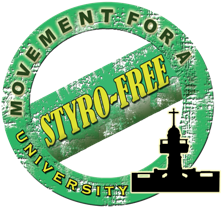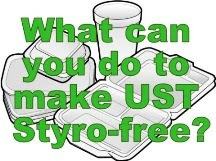Before the Styro-Free Campaign launch ended last Sept. 3, we asked participants (composed of students, faculty, administrators, and support staff) if they were ready to be Styro-free. They signed "Styro-free pledges" with the following commitments:
- I commit my support for the UST Styro-free Campaign.
- I will go for the earth-friendly choice!
- I will make a difference in my organization/department. Being Styro-free starts from me.
We would like to welcome the following Thomasians to the Movement for a Styro-Free University. Cheers!
· Jappy Molina – Mediartrix
· Ng, Ka Long – AB-AES
· Mabalay, Adrian A. – Artlests Economics Society
· Remitio, Rex John R. – Arts and Letters Student Council
· Maria Carmen Janessa Bermas – ARKITRATO-Architecture
· Meryl Anne M. Tongio – HCS-UST Youth Chapter/Architecture
· Jose Romell Ramirez Jr. – Nursing Rotaract
· Bettina Rayos del Sol – Nursing
· Kriska Noelle V. Raymundo – Nursing
· Ervin Dominic H. Quizon – College of Nursing/Nursing Journal
· Rapisura, Kaern Diane M. – Nursing
· James Bryan V. Esteleydes – Red Cross Youth Council Central Executive Board
· Ramos, Romielle Grazel Joi H. – Nursing
· Jasper Lara D. Poresores – Nursing
· Raymond Pabilao – UST-AMV Rotaract
· To, Abigail C. – Rotaract-AMV
· Anthony I. Morallas – Biology Society
· Gaddi, Philip Israel S. – Central Student Council
· Jasper J. Gopez – College of Science Debate and Drama Society
· Rolando Vittorio B. Gatmaitan Jr. – SOCC
· Angela Lauren D. Fernando – SOCC
· Marice Cruz – UST SOCC
· Shena Gladdys P. Baylon – Pax Romana-Accountancy
· Maria Chona H. Delicana – UST Pax Romana
· Ranera, Marnin Christian L. – DOMNET
· Carlo Puddao – Nursing Varsity Council
· Karla Dominique A. Quiros – Rotaract-Nursing
· Protacio, Rianna Marie Cristin C. – Rotaract-Nursing
· Agnes Punsalan – Rotaract – Nursing Rotaract
· Cynthia B. Loza – CFAD
· Alcancia, Johannes Christia C. – Marian Evangelization Community (MEC)
· Justin Elizaga – Rotract Central
· Adrienne Marie R. del Val – Industrial Eng’g Circle
· Frederick Cuevas – EARTH UST
· Roseanne R. Carreon – UST-ISYS
· Princess Khristine D. Fernandez – UST-ISYS
· Michelle Angela C. Melo – UST-RCY Eng’g Unit
· De Guzma, Veronica Ann M. – Engineering Student Council
· Jason Roy A. Almare – Christ’s Youth in Action
· Bianca B. De Mesa – Becarios de Santo Tomas
· Arnica Mae C. Go – Community Achievers Association-Accountancy
· Annabelle C. Hilario – CD-CFAD/Coordinator
· Crescencio M .Doma Jr. – AB
· Glenda A. Vargas – Nursing
· Earl Francis R. Sumile – Nursing
· Itchan Concepcion – OSA
· Thelma Samson-Maraña – UST Office for Student Affairs
· Paolo Perlada – UST-CTHM-SC
· Dr. Ma. Salve C. Olalia – UST Health Service
· Pamella Queri – CFAD SC
· Jesica N. Espiritu – UST-UNICEF Volunteers
· Ong, Zolita Theresia P. – UST TDRC
· Acosta, Patricia – COMACH Science
· Guinina Camille V. Eroles – CASA
· Flores, Jan Patrick – DX1
· Gabriel Victor A. Galang – Accountancy Student Council
· Sabina C. Viernes – Library
· Dakki Bautista – CASA
· Judy Joy Nuñez – Tomasian Cable Television (TOMCAT)
· Cartago, Stephanie – Scarlet-Accountancy
· Nestor M. Ventura Jr. – Junior Philippine Institute of Accountants
· Paul Cabrera – COMACH Commerce Unit
· Vallance S. Edlagan – UST Microbiology Society
· Miguel V. Agbulos – MATHSOC
· Goldwin Gan – TomWeb!
· Arnesto, Anna Meliza D.C. – ARC DX1
· Yoma, Ma. Regina E. – EARTH UST
· Sy Sion Kiao – UNESCO
· Patricia Acosta – COMACH Science
· Joseph B. Badinas – UST Security Dept.
Are YOU ready to be Styro-free? Make the earth-friendly choice and say NO to STYRO!











